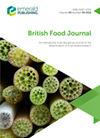How trustful are food safety control measures – insight into their validation
IF 3.4
3区 经济学
Q1 AGRICULTURAL ECONOMICS & POLICY
引用次数: 0
Abstract
PurposeThe main purpose of this paper was to evaluate the validation process of food safety control measures.Design/methodology/approachThe validation of control measures has been analyzed at 50 food companies in Serbia. The sample included companies that produce food of both plant and animal origin and have certified food safety management systems. A total of 156 control measures that combat physical hazards (41.6%), followed by microbial hazards (34.0%) and chemical hazards (24.4%), have been analyzed. To enable quantification of the validation protocols, each control measure was assigned a score.FindingsThe validation scores showed that the highest level of validation was observed in large companies, as opposed to small and medium-sized companies (p < 0.05). The type of food safety hazards and the food sector did not reveal any statistical differences in-between the scores. The main approach to validating control measures was referring to the technical documentation of equipment used (52.6%), followed by scientific and legal requirements (30.7%). Less than 20% of the analyzed control measures were validated with operational data collected on-site. No mathematical modeling was observed for the sampled food companies. Future steps should include the development of validation guides for different types of control measures and training modules.Practical implicationsThis study can serve as an improvement guide for food safety consultants, food safety auditors, certification bodies, inspection services, food technologists and food managers.Originality/valueThis study is one of the first to provide an insight into how food companies validate their control measures to combat microbial, chemical and physical food safety hazards.食品安全控制措施的可信度--深入了解其验证情况
目的本文的主要目的是评估食品安全控制措施的验证过程。样本包括生产植物和动物源性食品并拥有经认证的食品安全管理系统的公司。共分析了 156 项控制措施,这些措施主要针对物理危害(41.6%),其次是微生物危害(34.0%)和化学危害(24.4%)。为了对验证协议进行量化,对每项控制措施都进行了评分。研究结果 验证评分显示,大型企业的验证水平最高,而中小型企业的验证水平最低(p < 0.05)。食品安全隐患类型和食品行业的得分之间没有任何统计差异。验证控制措施的主要方法是参考所用设备的技术文件(52.6%),其次是科学和法律要求(30.7%)。不到 20%的分析控制措施是通过现场收集的运行数据验证的。在抽样调查的食品公司中,没有发现数学模型。本研究可作为食品安全顾问、食品安全审核员、认证机构、检验服务机构、食品技术人员和食品管理人员的改进指南。
本文章由计算机程序翻译,如有差异,请以英文原文为准。
求助全文
约1分钟内获得全文
求助全文
来源期刊

British Food Journal
工程技术-食品科技
CiteScore
6.90
自引率
15.20%
发文量
219
审稿时长
18-36 weeks
期刊介绍:
After 115 years, the British Food Journal (BFJ) continues to be highly respected worldwide for its broad and unique interdisciplinary coverage of the latest food-related double blind peer-reviewed research. It links all sectors of this dynamic industry, keeping abreast of emerging trends, topical and controversial issues and informing and stimulating debate. - See more at: http://emeraldgrouppublishing.com/products/journals/journals.htm?id=bfj#sthash.O3wH4pEh.dpuf
 求助内容:
求助内容: 应助结果提醒方式:
应助结果提醒方式:


